| |
|
Xiamen Oil Paintings, Wholesale Direct!
|
|
100% hand painted, 100% cotton canvas, 100% money back if not satisfaction. |
|
|
|
|
ART WORKS INDEX
A
B
C
D
E
F
G
H
I
J
K
L
M
N
O
P
Q
R
S
T
U
V
W
X
Y
Z
|
|
ARTISTS INDEX
A
B
C
D
E
F
G
H
I
J
K
L
M
N
O
P
Q
R
S
T
U
V
W
X
Y
Z
|
|
|
|
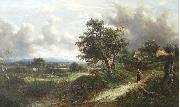 |
Joseph Thors
|
|
(ca. 1835 - 1884) was an English landscape artist who exhibited widely in England during the late 19th century.
Relatively little is known about Thors's life though he was recorded as living and working in London, then Birmingham - he also travelled for a while in France. He exhibited at the Royal Academy of Arts, British Institution, and Society of British Artists in London, and was also exhibited in Birmingham between 1869 - 1900.
|
|
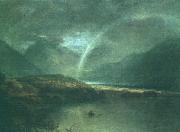 |
Joseph Mallord William Turner
|
|
English Romantic Painter, 1775-1851
Joseph Mallord William Turner (23 April 1775 ?C 19 December 1851) was an English Romantic landscape painter, watercolourist and printmaker, whose style is said to have laid the foundation for Impressionism. Although Turner was considered a controversial figure in his day, he is now regarded as the artist who elevated landscape painting to an eminence rivalling history painting.
Turner's talent was recognised early in his life. Financial independence allowed Turner to innovate freely; his mature work is characterised by a chromatic palette and broadly applied atmospheric washes of paint. According to David Piper's The Illustrated History of Art, his later pictures were called "fantastic puzzles." However, Turner was still recognised as an artistic genius: the influential English art critic John Ruskin described Turner as the artist who could most "stirringly and truthfully measure the moods of Nature." (Piper 321)
Suitable vehicles for Turner's imagination were to be found in the subjects of shipwrecks, fires (such as the burning of Parliament in 1834, an event which Turner rushed to witness first-hand, and which he transcribed in a series of watercolour sketches), natural catastrophes, and natural phenomena such as sunlight, storm, rain, and fog. He was fascinated by the violent power of the sea, as seen in Dawn after the Wreck (1840) and The Slave Ship (1840).
Turner placed human beings in many of his paintings to indicate his affection for humanity on the one hand (note the frequent scenes of people drinking and merry-making or working in the foreground), but its vulnerability and vulgarity amid the 'sublime' nature of the world on the other hand. 'Sublime' here means awe-inspiring, savage grandeur, a natural world unmastered by man, evidence of the power of God - a theme that artists and poets were exploring in this period. The significance of light was to Turner the emanation of God's spirit and this was why he refined the subject matter of his later paintings by leaving out solid objects and detail, concentrating on the play of light on water, the radiance of skies and fires. Although these late paintings appear to be 'impressionistic' and therefore a forerunner of the French school, Turner was striving for expression of spirituality in the world, rather than responding primarily to optical phenomena.
Rain, Steam and Speed - The Great Western Railway painted (1844).His early works, such as Tintern Abbey (1795), stayed true to the traditions of English landscape. However, in Hannibal Crossing the Alps (1812), an emphasis on the destructive power of nature had already come into play. His distinctive style of painting, in which he used watercolour technique with oil paints, created lightness, fluency, and ephemeral atmospheric effects. (Piper 321)
One popular story about Turner, though it likely has little basis in reality, states that he even had himself "tied to the mast of a ship in order to experience the drama" of the elements during a storm at sea.
In his later years he used oils ever more transparently, and turned to an evocation of almost pure light by use of shimmering colour. A prime example of his mature style can be seen in Rain, Steam and Speed - The Great Western Railway, where the objects are barely recognizable. The intensity of hue and interest in evanescent light not only placed Turner's work in the vanguard of English painting, but later exerted an influence upon art in France, as well; the Impressionists, particularly Claude Monet, carefully studied his techniques.
|
|
|
|
 |
Joseph Heintz the Elder
|
|
the Elder (Basle, 11 June 1564 - near Prague, Bohemia, October 1609) was a Swiss painter, draftsman and architect.
He appears to have been a pupil of Hans Bock, and to have educated himself by diligent practice in copying the works of Hans Holbein the younger. Between 1585 and 1587 he lived in Rome, registering himself a pupil; to Hans von Aachen. He next settled in Bohemia in 1591, and was at once appointed court painter to Rudolf II, but he remained in Prague for two years only, as in 1593 he was commissioned to make some copies from the antique for the emperor, and for that purpose went to Rome, where he spent some years. In 1604 we hear of him in Augsburg, and from the time we know little of his history, until his decease is recorded in a village outside of Prague.
Heintz's paintings included religious images, portraits, and, following the emperor's taste, erotic mythological themes. They were at one time in high demand, but later on suffered an eclipse. Among them are a family portrait in Berne and that of Rudolf II in Vienna. He was constantly investigating subtle questions of light, and almost all of his landscapes show the interest he took in this technical matter. A notable work by him is the Rape of Proserpine, which hangs in the Dresden Gallery, and was engraved by Lukas Kilian; in the same gallery are two other works, Lot and His Daughters and Ecce Homo. Finally there is his portrait of Constance of Austria. He had a son, who bore the same name, and who painted a few religious pictures; several of these works hitherto attributed to the son are now believed to be late productions by the father.
|
|
|
|
|
|
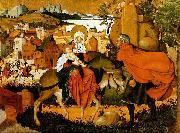 |
Jorg Breu the Elder
|
|
(c. 1475 -- 1537), of Augsburg, was a painter of the German Danube school. He was the son of a weaver.
He journeyed to Austria and created several multi-panel altarpieces there in 1500-02, such as the Melk Altar (1502). He returned to Augsburg in 1502 where he became a master. He travelled to Italy twice, in ca. 1508 and in 1514/15.
After his death in 1537, his son, Jörg Breu the Younger continued to lead his Augsburg workshop until his own death 10 years later.
|
|
|
|
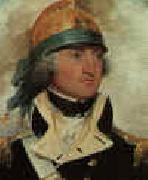 |
John Trumbull
|
|
1756-1843
John Trumbull Gallery
Trumbull was born in Lebanon, Connecticut, to Jonathan Trumbull, who was Governor of Connecticut from 1769 to 1784. He entered the 1771 junior class at Harvard University at age fifteen and graduated in 1773. Due to a childhood accident, Trumbull lost use of one eye, which may have influenced his detailed painting style.
As a soldier in the American Revolutionary War, Trumbull rendered a particular service at Boston by sketching plans of the British works, and witnessed the famous Battle of Bunker Hill. He was appointed second personal aide to General George Washington, and in June 1776 deputy adjutant-general to General Horatio Gates, but resigned from the army in 1777.
In 1780 he traveled to London where he studied under Benjamin West, who suggested to him that he paint small pictures of the War of Independence and miniature portraits, of which he produced about 250 in his lifetime.
On September 23, 1780 and October 2, 1780, British agent Major John Andr?? was, respectively, captured and hanged as a spy in America. News reached Europe, and as an officer of similar rank as Andr?? in the Continental Army, Trumbull was imprisoned for seven months in London's Tothill Fields Bridewell.
In 1784 he was again in London working under West, in whose studio he painted his Battle of Bunker Hill and Death of Montgomery, both of which are now in the Yale University Art Gallery.
In 1785 Trumbull went to Paris, where he made portrait sketches of French officers for The Surrender of Cornwallis, and began, with the assistance of Jefferson, Declaration of Independence, well-known from the engraving by Asher Brown Durand. This latter painting was purchased by the United States Congress along with his Surrender of General Burgoyne, Surrender at Yorktown, and Washington Resigning his Commission, and these paintings now hang in the United States Capitol. Trumbull's The Sortie Made by the Garrison of Gibraltar, 1789, owned by the Boston Athenaeum, is now in the Boston Museum of Fine Arts.
|
|
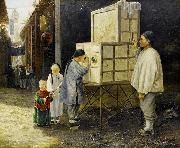 |
John Thomson
|
|
John Thomson (14 June 1837 - 29 September 1921) was a pioneering Scottish photographer, geographer and traveller. He was one of the first photographers to travel to the Far East, documenting the people, landscapes and artifacts of eastern cultures. Upon returning home, his work among the street people of London cemented his reputation, and is regarded as a classic instance of social documentary which laid the foundations for photojournalism. He went on to become a portrait photographer of High Society in Mayfair, gaining the Royal Warrant in 1881.
The son of William Thomson, a tobacco spinner and retail trader, and his wife Isabella, Thomson was born the eighth of nine children in Edinburgh in the year of Queen Victoria's accession. After his schooling in the early 1850s, he was apprenticed to a local optical and scientific instrument manufacturer, thought to be James Mackay Bryson. During this time, Thomson learned the principles of photography and completed his apprenticeship around 1858.
During this time he also undertook two years of evening classes at the Watt Institution and School of Arts (formerly the Edinburgh School of Arts, later to become Heriot-Watt University). He received the "Attestation of Proficiency" in Natural Philosophy in 1857 and in Junior Mathematics and Chemistry in 1858. In 1861 he became a member of the Royal Scottish Society of Arts, but by 1862 he had decided to travel to Singapore to join his older brother William, a watchmaker and photographer.
|
|
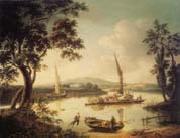 |
John Thomas Serres
|
|
1759-1825 English painter, born in London in December 1759. He was the eldest son of Dominic (1722-93), a successful marine painter who was to be one of the founder members of the Royal Academy.Son of Dominic Serres. John Thomas Serres's colourful career began with landscape painting. He later travelled extensively, spending periods in Paris (1789), Rome and Naples (1790-91), before succeeding his father to the office of Marine Painter to George III in 1793. He worked promisingly as a painter (in both oils and watercolour) of sea-pieces in the European tradition, advanced in England by Phillipe Jacques de Loutherbourg. After becoming Marine Draughtsman to the Admiralty in 1800 he took on the less challenging employment of making drawings and elevations of the west coasts of France and Spain. This connection with the Navy was probably related to his appointment as drawing instructor at Chelsea Naval School, London.
|
|
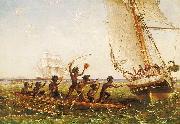 |
John Thomas Baines
|
|
(John) Thomas Baines (27 November 1820 - 8 May 1875) was an English artist and explorer of British colonial southern Africa and Australia. Born in King's Lynn, Norfolk, Baines was apprenticed to a coach painter at an early age. When he was 22 he left England for South Africa aboard the "Olivia" (captained by a family friend William Roome) and worked for a while in Cape Town as a scenic and portrait artist, and as official war artist during the so-called Eighth Frontier War for the British Army.
|
|
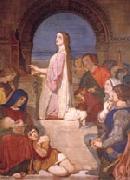 |
John Tenniel
|
|
English Golden Age Cartoonist and Illustrator.
(1820-1914)
English illustrator and painter. Impatient with the hierarchic structure of the curriculum at the Royal Academy schools in London, he left to follow a less formal education at the Clipstone Street Art Society's life and anatomy classes and in the British Museum's sculpture galleries and Print Room. His research into the history of costume and armour provided material for his early oils of chivalric scenes, which he exhibited at the Royal Academy (1837-42, 1851). Tenniel was among the artists commissioned to decorate the New Palace of Westminster, and he went in 1845 on a state-sponsored trip to Munich to study fresco technique. His contact with the school of Peter Cornelius while there confirmed his emphatic preference for a precisely drawn line.
|
|
|
|
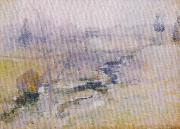 |
John Henry Twachtman
|
|
American Impressionist Painter, 1853-1902
American painter and printmaker. He began as a painter of window-shades but developed one of the most personal and poetic visions in American landscape painting, portraying nature on canvases that were, in the words of Childe Hassam, 'strong, and at the same time delicate even to evasiveness'. His first artistic training was under Frank Duveneck, with whom he studied first in Cincinnati and then in Munich (1875-7). His absorption of the Munich style, characterized by bravura brushwork and dextrous manipulation of pigment, with the lights painted as directly as possible into warm,
|
|
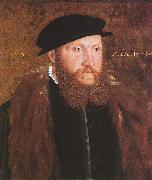 |
John Bettes the Elder
|
|
(active c. 1531 - 1570) was a Tudor artist whose few known paintings date from between about 1543 and 1550. His most famous work is his Portrait of a Man in a Black Cap. His son John Bettes the Younger, with whom he is sometimes confused, was a pupil of Nicholas Hilliard who painted portraits during the reign of Elizabeth I and James I.
Nothing is known of John Bettes's life, except that he was living in Westminster in 1556, according to a documented court case. He is first recorded as working for Henry VIII at Whitehall Palace in 1531. Queen Catherine Parr's accounts for 1546/47 record payments to Bettes for "lymning" (painting in miniature) the king's and queen's portraits, and for six other portraits. Her new year's gift of 1547 to Prince Edward was a pair of portraits of the king and herself. Bettes has been identified as the designer of the engraved title-border for William Cuningham's Cosmographical Glasse, printed by John Day in 1559. He may also be the designer of engravings for Edward Hall's Chronicle, published in 1550, and of a woodcut portrait of Franz Burchard, the Saxon ambassador to England, published in 1560. In 1576, John Foxe referred to Bettes as already dead. An earlier second edition of Foxe's Actes and Monuments printed in 1570 refers to Bettes' death.
|
|
|
|
 |
johann tischbein
|
|
Johann Heinrich Wilhelm Tischbein, also known as Goethe-Tischbein (15 February 1751 in Haina ?C 26 February 1828 in Eutin) was a German painter. He was a descendant of the Tischbein family of painters, and a pupil of his uncle Johann Jacob Tischbein.
Like many contemporary colleagues, Tischbein lived in Rome for some years. During his first stay in Rome (1779?C1781) his style changed from Rococo to Neoclassicism. He painted landscapes, historical scenes and still lifes. His second stay in Rome lasted 16 years (1783?C1799). He met Johann Wolfgang von Goethe there in 1786, made friends with him and accompanied him to Naples in 1787. Later, Goethe recounted this travel in his Italian Journey. Also in 1787, Tischbein painted his most famous work, a portrait of Goethe as a traveller in the Roman Campagna (now in the Städel museum, Frankfurt am Main).
From 1808, Tischbein was a painter at the court of Oldenburg in Northern Germany.
|
|
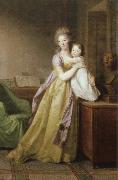 |
johann friedrich august tischbein
|
|
German Painter, 1750-1812. 1750 Maastricht ?C Heidelberg 1812. First he was a pupil of his father Johann Valentin Tischbein (1715-1768) in Hildburghausen, from 1768 one of his uncle Johann Heinrich Tischbein the elder (1722-1789) in Kassel.
Supported by Prince Friedrich von Waldeck he stayed in Paris from 1772 until 1777, where he studied at the academy of arts under N. B. L??pici?? (1735-1784).
Afterwards he travelled to Rome, where he got in contact with the painters A.R. Mengs (1728-1779), J.L. David (1748-1825) and Fr.H. F??ger (1751-1818) and probably also with the English style of portrait painting. 1779 he travelled to Naples.
In 1780 he returned to Arolsen via Vienna, Munich, Stuttgart and Kassel, where he worked for the Prince of Waldeck. From 1780 he was his councillor
and court painter. During this time he made several journeys e.g. to Holland and after 1785 to Weimar where he met Wieland (1785), Schlegel (1792) and other important people.
From 1795 he worked for Leopold III. of Anhalt-Dessau. 1800 he succeeded A. Fr. Oeser (1717-1799) as director of the academy of arts in Leipzig. From 1806 to 1808 he stayed in St Petersburg. He died 1812 when he visited his daughter Caroline Wilken (1783-1843) in Heidelberg
|
|
 |
Johan Thorn Prikker
|
|
1868-1932 Dutch Johan Thorn Prikker Gallery
Dutch painter, printmaker, mosaicist and stained-glass artist. He attended the Koninklijke Academie van Beeldende Kunsten in The Hague (1881-8). During this period he painted mainly landscapes in the style of The Hague school. Until c. 1896 he produced Symbolist works, in which the emphatic line flow and the subtle colour shading are especially noticeable, for example The Bride (1893; Otterlo, Kr?ller-M?ller). From 1892 until 1897 he corresponded with Henri Borel, partly about his Symbolist work, often drawing in the letters. During this time he came into close contact with Belgian artists, in particular with Henry Van de Velde through whom he was able to exhibit with Les XX in Brussels. In summer he regularly stayed in Vise, where he produced pastel drawings in a rhythmic pointillism, a style with which he could achieve a form of abstraction.
|
|
|
|
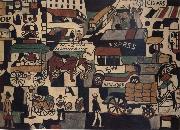 |
Joaquin Torres-Garcia
|
|
Uruguayan Painter and Sculptor, 1874-1949,was a Uruguayan artist (in a variety of media) and art theorist, also known as the founder of Constructive Universalism. Born in Montevideo, Torres Garcia later travelled extensively, and lived for some time in Barcelona, New York, Paris, and Madrid. He returned to Uruguay in 1934.
|
|
|
|
 |
Jmw Turner
|
|
1775-1851
British landscape painter. The son of a barber, he entered the Royal Academy school in 1789. In 1802 he became a full academician and in 1807 was appointed professor of perspective. His early work was concerned with accurate depictions of places, but he soon learned from Richard Wilson to take a more poetic and imaginative approach. The Shipwreck (1805) shows his new emphasis on luminosity, atmosphere, and Romantic, dramatic subjects. After a trip to Italy in 1819, his colour became purer and more prismatic, with a general heightening of key. In later paintings, such as Sunrise, with a Boat Between Headlands (1845), architectural and natural details are sacrificed to effects of colour and light, with only the barest indication of mass. His compositions became more fluid, suggesting movement and space. In breaking down conventional formulas of representation, he anticipated French Impressionism. His immense reputation in the 19th century was due largely to John Ruskin's enthusiasm for his early works
|
|
|
|
|
|
 |
Jeremiah Theus
|
|
(April 5, 1716 - May 17, 1774) was a Swiss-born American painter, primarily of portraits. He was active mainly around Charleston, South Carolina, in which city he remained almost without competition for the bulk of his career.
Theus was born in the city of Chur, in the Swiss canton of Graubenden, and was the eldest child of Simeon and Anna Walser Thees. He was nineteen when he immigrated with his family to the Province of South Carolina, whose General Assembly had provided land grants and transport funds to encourage European Protestants to settle in the colony. Simeon Thes was given 250 acres (1.0 km2) of land along the Edisto River in what was then Orangeburgh Township,
|
|
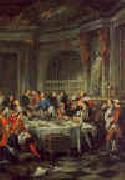 |
Jean-Francois De Troy
|
|
French
1679-1752
Jean-Francois
De Troy Gallery
Jean François de Troy was born on January 27, 1679 in Paris. The successful career of Jean François de Troy was based initially on large historical and allegorical compositions, such as Time Unveiling Truth (1733) in the National Gallery, London, but he is now most highly regarded for his smaller and more spirited scenes of elegant social life. They are among the best of those that rode on the wave of Watteau's success??indeed The Alarm, or the Gouvernante Fid??le (Victoria and Albert Museum, London, 1723) was attributed to Watteau in the 19th century. A versatile artist, he made tableaux de modes famous, painting histories and mythologies in a colourful and fluent manner which owed something to both Veronese and Peter Paul Rubens.
He undertook commissions for Versailles and Fontainebleau between 1724 and 1737, and designed two sets of tapestries for the Gobelins, each of seven subjects, the Histoire d'Esther (1737-40) and the Histoire de Jason (1743-6).
In 1738 he was appointed Director of the French Academy in Rome, and spent the rest of his life there. De Troy's wife died prematurely, and he lost of all his seven children. Jean François de Troy died on January 26, 1752 in Rome.
|
|
 |
Jean joseph Taillasson
|
|
French Painter , Bordeaux 1745-1809 Paris
was a French history painter and portraitist, draftsman and art critic, who matured his talent in the Paris ateliers of Joseph-Marie Vien (from 1764) and Nicolas Bernard L??pici?? and, having won third place in the Prix de Rome competition, 1769, spent four years, 1773-77, in Italy. At his return to Paris he set an early example of neoclassicism. His Observations sur quelques grands peintres, (Paris, Duminil-Lesueur) 1807, offered anti-academic advice somewhat at variance with his own manner
|
|
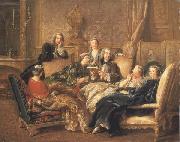 |
Jean Francois de troy
|
|
French Neoclassical Painter, 1679-1752
was a French Rococo painter and tapestry designer. He was one of a family of painters, being the son of the portrait painter François de Troy (1645-1730), under whom he first studied, and at whose expense he went to Italy 1699-1706, staying in Rome, but also visiting many north Italian cities. Jean François de Troy was born on January 27, 1679 in Paris. The successful career of Jean François de Troy was based initially on large historical and allegorical compositions, such as Time Unveiling Truth (1733) in the National Gallery, London, but he is now most highly regarded for his smaller and more spirited scenes of elegant social life. They are among the best of those that rode on the wave of Watteau's success indeed The Alarm, or the Gouvernante Fidele (Victoria and Albert Museum, London, 1723) was attributed to Watteau in the 19th century. A versatile artist, he made tableaux de modes famous, painting histories and mythologies in a colourful and fluent manner which owed something to both Veronese and Peter Paul Rubens. He undertook commissions for Versailles and Fontainebleau between 1724 and 1737, and designed two sets of tapestries for the Gobelins, each of seven subjects, the Histoire d'Esther (1737-40) and the Histoire de Jason (1743-6).
|
|
|
|
|
|
 |
Jan Toorop
|
|
1858-1928
Dutch Jan Toorop Gallery
He moved to the Netherlands in 1872 and took a course in drawing at the Polytechnische School in Delft (1876-9). He also studied at the Rijksakademie voor Beeldende Kunsten in Amsterdam (1880-82) and at the Ecole des Arts D?coratifs in Brussels (1882-5). In Amsterdam he joined the St Lukas Society, and in Belgium he was a founder-member of Les XX in 1884. Although he had met Jozef Isra?ls in 1880 and respected the style of the Hague school, he was more attracted by what he saw in Brussels, particularly work by French artists. His portraits of 1884 are painted in an Impressionist style. With other members of Les XX he trained himself in plein-air; he learnt from James Ensor how to apply colours with a palette knife and how to use white with the same intensity as other colours. His style, however, remained austere and his scenes of workmen show a sensitive realism reminiscent of Gustave Courbet's work, for example Respect for the Dead.
|
|
 |
Jan Thorn-Prikker
|
|
(June 5, 1868, The Hague - March 5, 1932, Cologne) was a Dutch painter and designer in the Art Nouveau style. He was an important figure in religious art, best known for his stained glass windows. His most famous painting is the mystical The Bride (1893), in the Kroller-Muller Museum, Otterlo.
|
|
|
|
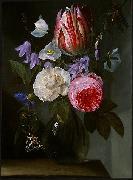 |
Jan Philip van Thielen
|
|
(Mechelen, 1618 - Mechelin, 1667) was a Flemish Baroque painter who specialized in flowers.
Van Thielen was the son of a minor nobleman and eventually assumed the title of Lord of Couwenberch. In 1631 or 1632 he began studying at the age of thirteen with his future brother-in-law, the history painter Theodoor Rombouts (1597-1637), and in 1641 he commenced his studies with the flower painter Daniel Seghers (1590-1661). According to Houbraken (who mistakenly wrote his birth year as 1681 instead of 1618), his reputation during his lifetime was such that he received patronage from the Spanish crown,
|
|
 |
Jan Jansz. Treck
|
|
(1606, Amsterdam, 25 September 1652 ) was a still-life painter during the Dutch Golden Age. Treck used economy in the number of his objects.
In 1623 Treck was trained for half a year by Jan den Uyl, who had married his sister Geertruid in 1619. His style also shows influence by Pieter Claesz and Willem Heda. In 1643 and 1644 Treck was trained by Abraham Jansz for 4 guilders a week, but forgot to pay for his apprenticeship. He also had to pay for a window that was made to get more light, while working.
His earliest known signed and dated work is from 1641, after the death of Den Uyl. A work has surfaced with both signatures, implying that Treck perhaps finished Den Uyl's paintings after his death. Treck also had helped his brother-in-law to sell his house (on Singel) in 1639. After the death of his friend Abraham, Treck bought his equipment, paint and easel. In 1640 he supplied the art dealer Hendrick Uylenburgh with money.
After Treck's death his brother, sister and his niece and nephews inherited a small house in an alley from Singel to Spuistraat, furniture, clothes, stocks, coins, jewelry, prints and paintings. In 1661 Simon Luttichuys was asked to repaint a vanitas done by Treck.
Treck influenced Pieter van Anraedt and Willem Kalf.
|
|
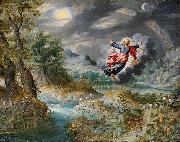 |
Jan Brueghel the Younger
|
|
(September 13, 1601 C September 1, 1678) was a Flemish Baroque painter, and the son of Jan Brueghel the Elder.
He was trained by his father and spent his career producing works in a similar style. Along with his brother Ambrosius, he produced landscapes, allegorical scenes and other works of meticulous detail. Brueghel also copied works by his father and sold them with his father's signature. His work is distinguishable from that of his parent by being less well executed and lighter.
Jan the Younger was traveling in Italy when his father died of cholera and swiftly returned to take control of the Antwerp studio. He soon established himself and was made dean of the Guild of Saint Luke in 1630. That same year he was commissioned by the French court to paint Adam Cycle. In the following years, he also produced paintings for the Austrian court, and worked independently in Paris, before returning to Antwerp in 1657. He collaborated with a number of prominent artists including Rubens, Hendrick van Balen (1575-1632), Adriaen Stalbemt (1580-1682), Lucas Van Uden (1596-1672), David Teniers the Younger and his father-in-law Janssen. Jan the Younger's best works are his extensive landscapes, either under his own name or made for other artists such as Hendrick van Balen as backgrounds.
|
|
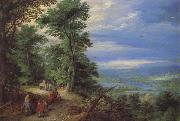 |
Jan Brueghel The Elder
|
|
Flemish Baroque Era Painter, 1568-1625
was a Flemish painter, son of Pieter Brueghel the Elder and father of Jan Brueghel the Younger. Nicknamed "Velvet" Brueghel, "Flower" Brueghel, and "Paradise" Brueghel, of which the latter two were derived from favored subjects, while the former may refer to the velveteen sheen of his colors or to his habit of wearing velvet. He was born in Brussels. His father died in 1569, and then, following the death of his mother in 1578, Jan, along with his brother Pieter Brueghel the Younger ("Hell Brueghel") and sister Marie, went to live with their grandmother Mayken Verhulst (widow of Pieter Coecke van Aelst). She was an artist in her own right, and according to Carel van Mander, possibly the first teacher of the two sons. The family moved to Antwerp sometime after 1578. He first applied himself to painting flowers and fruits, and afterwards acquired considerable reputation by his landscapes and sea-pieces. He formed a style more independent of his father's than did his brother Pieter the Younger. His early works are often landscapes containing scenes from scripture, particularly forest landscapes betraying the influence of the master forest landscape-painter Gillis van Coninxloo. Later in his career, he moved toward the painting of pure landscapes and townscapes, and, toward the end, of still lifes. After residing long at Cologne he travelled into Italy, where his landscapes, adorned with small figures, were greatly admired. He left a large number of pictures, chiefly landscapes, which are executed with great skill. Many of his paintings are collaborations in which figures by other painters were placed in landscapes painted by Jan Brueghel.
|
|
 |
James Tissot
|
|
French Painter, 1836-1902
French painter, printmaker and enamellist. He grew up in a port, an experience reflected in his later paintings set on board ship. He moved to Paris c. 1856 and became a pupil of Louis Lamothe and Hippolyte Flandrin. He made his Salon d?but in 1859 and continued to exhibit there successfully until he went to London in 1871. His early paintings exemplify Romantic obsessions with the Middle Ages, while works such as the Meeting of Faust and Marguerite (exh. Salon 1861; Paris. Mus. d'Orsay) and Marguerite at the Ramparts (1861; untraced, see Wentworth, 1984, pl. 8) show the influence of the Belgian painter Baron Henri Leys. In the mid-1860s Tissot abandoned these tendencies in favour of contemporary subjects, sometimes with a humorous intent, as in Two Sisters (exh. Salon 1864; Paris, Louvre) and Beating the Retreat in the Tuileries Gardens (exh. Salon 1868; priv. col., see Wentworth, 1984, pl. 45). The painting Young Ladies Looking at Japanese Objects (exh. Salon 1869; priv. col., see Wentworth, 1984, pl. 59) testifies to his interest in things Oriental, and Picnic (exh. Salon 1869; priv. col., see 1984 exh. cat., fig. 27), in which he delved into the period of the Directoire, is perhaps influenced by the Goncourt brothers. Tissot re-created the atmosphere of the 1790s by dressing his characters in historical costume.
|
|
 |
James Joseph Jacques Tissot
|
|
James Jacques Joseph Tissot (15 October 1836 - 8 August 1902) was a French painter, who spent much of his career in Britain.
Tissot was born in Nantes, France. In about 1856, he began study at the École des Beaux-Arts in Paris under Hippolyte Flandrin and Lamothe, and became friendly with Edgar Degas and James Abbott McNeill Whistler. Tissot exhibited in the Paris Salon for the first time in 1859, two portraits of women and three scenes in medieval dress from Faust. The latter show the influence of the Belgian painter Henri Leys (Jan August Hendrik Leys), whom he had met in Antwerp in 1859. In the mid-1860s, however, Tissot began to concentrate on depicting women, often although not always shown in modern dress. Like contemporaries such as Alfred Stevens and Claude Monet, Tissot also explored japonisme, including Japanese objects and costumes in his pictures. A portrait of Tissot by Degas from these years (Metropolitan Museum of Art, New York) shows him with a Japanese screen hanging on the wall.
|
|
 |
James Jacques Joseph Tissot
|
|
(15 October 1836 -- 8 August 1902) was a French painter.
Tissot was born at Nantes. He studied at the École des Beaux-Arts in Paris under Ingres, Flandrin and Lamothe, and exhibited in the Paris Salon for the first time at the age of twenty-three. In 1861 he showed The Meeting of Faust and Marguerite, which was purchased by the state for the Luxembourg Gallery. His first characteristic period made him a painter of the charms of women. Demi-mondaine would be more accurate as a description of the series of studies which he called La Femme a Paris.
|
|
 |
Jacopo Torriti
|
|
Italian painter, Roman school active c. 1270-1300, Italian painter and mosaicist. Two mosaics in Rome are signed by him: one, on the apse of S Giovanni in Laterano, that once bore the date 1291 (or, according to some sources, 1290 or 1292); and another on the apse and triumphal arch of S Maria Maggiore, now replaced by a 19th-century restoration but at one time dated 1295 or 1296. Torriti is also known to have executed a mosaic for Arnolfo di Cambio's tomb of Pope Boniface VIII (1296; destr.; see ARNOLFO DI CAMBIO) in Old St Peter's, Rome. Torriti was active during the same period as Cimabue and Giotto, Pietro Cavallini and Arnolfo di Cambio, but his fame has been obscured by theirs, no doubt because of his closer links with Byzantine art. He was nevertheless one of the most important artists working in Rome during the papacy of Nicholas IV (1288-92) and was entrusted with some of the most prestigious commissions of the day.
|
|
 |
Jacopo Tintoretto
|
|
1518-1594
Italian painter. His father was a silk dyer (tintore); hence the nickname Tintoretto ("Little Dyer"). His early influences include Michelangelo and Titian. In Christ and the Adulteress (c. 1545) figures are set in vast spaces in fanciful perspectives, in distinctly Mannerist style. In 1548 he became the centre of attention of artists and literary men in Venice with his St. Mark Freeing the Slave, so rich in structural elements of post-Michelangelo Roman art that it is surprising to learn that he had never visited Rome. By 1555 he was a famous and sought-after painter, with a style marked by quickness of execution, great vivacity of colour, a predilection for variegated perspective, and a dynamic conception of space. In his most important undertaking, the decoration of Venice's Scuola Grande di San Rocco (1564 ?C 88), he exhibited his passionate style and profound religious faith. His technique and vision were wholly personal and constantly evolving.
|
|
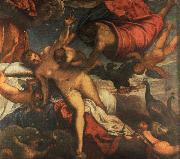 |
Jacopo Robusti Tintoretto
|
|
1518-1594
Italian Tintoretto Galleries
The real name of Tintoretto was Jacopo Robusti, but he is better known by his nickname, meaning the "little dyer, " his father having been a silk dyer. The artist was born in Venice and lived there all his life. Even though his painting is distinguished by great daring, he seems to have led a rather retired life, concerned only with his work and the well-being of his family. His daughter Marietta and his sons Domenico and Marco also became painters, and Domenico eventually took over the direction of Tintoretto's large workshop, turning out reliable but un-inspired pictures in the manner of his father. Some of them are, on occasion, mistaken for works of the elder Tintoretto.
Tintoretto appears to have studied with Bonifazio Veronese or Paris Bordone, but his true master, as of all the great Venetian painters in his succession, was Titian. Tintoretto's work by no means merely reflects the manner of Titian. Instead he builds on Titian's art and brings into play an imagination so fiery and quick that he creates an effect of restlessness which is quite opposed to the staid and majestic certainty of Titian's statements. If Tintoretto's pictures at first sight often astonish by their melodrama, they almost inevitably reveal, at closer observation, a focal point celebrating the wonders of silence and peace. The sensation of this ultimate gentleness, after the first riotous impact, is particularly touching and in essence not different from what we find (although brought about by very different means) in the pictures of Titian and Paolo Veronese.
Tintoretto was primarily a figure painter and delighted in showing his figures in daring foreshortening and expansive poses. His master in this aspect of his art was Michelangelo. Tintoretto is supposed to have inscribed on the wall of his studio the motto: "The drawing of Michelangelo and the color of Titian." Unlike Michelangelo, however, Tintoretto worked and drew very quickly, using only lights and shadows in the modeling of his forms, so that his figures look as if they had gained their plasticity by a kind of magic. In the rendering of large compositions he is reported to have used as models small figures which he made of wax and placed or hung in boxes so cleverly illuminated that the conditions of light and shade in the picture he was painting would be the same as those in the room in which it was to be hung.
|
|
|
|
|
|
|
|
 |
J.M.W.Turner
|
|
English Romantic Painter, 1775-1851, British land- and seascape artist. Born in London the son of a barber, Turner was precociously talented. He entered the RA Schools in 1789, had a drawing exhibited at the academy in 1790, and was elected a full academician in 1802. He became professor of perspective in 1807. A prolific artist of amazing range of subject and style, he began work in water-colours, quickly founding both a reputation and a fortune, which made him independent of changing public taste. His work was not appreciated by everyone, but his supporters included Thomas Lawrence, John Ruskin, and the earl of Egremont. He died in eccentric obscurity under a false name.
|
|
 |
J.M.W. Turner
|
|
English Romantic Painter, 1775-1851 landscape master
landscape master .British painter and printmaker. He dominated British landscape painting throughout the first half of the 19th century. He established a reputation in the Royal Academy, London, first as a topographical watercolourist and then within a few years as a painter of Sublime and historical landscapes.
|
|
|
|
|
|
|
|
|
| Wholesale China Oil Painting Wholesale Oil Painting China Xiamen Portrait Reproduction on canvas Chinese Oil Painting Wholesale USA Oil Painting |
|
|
|
|
|